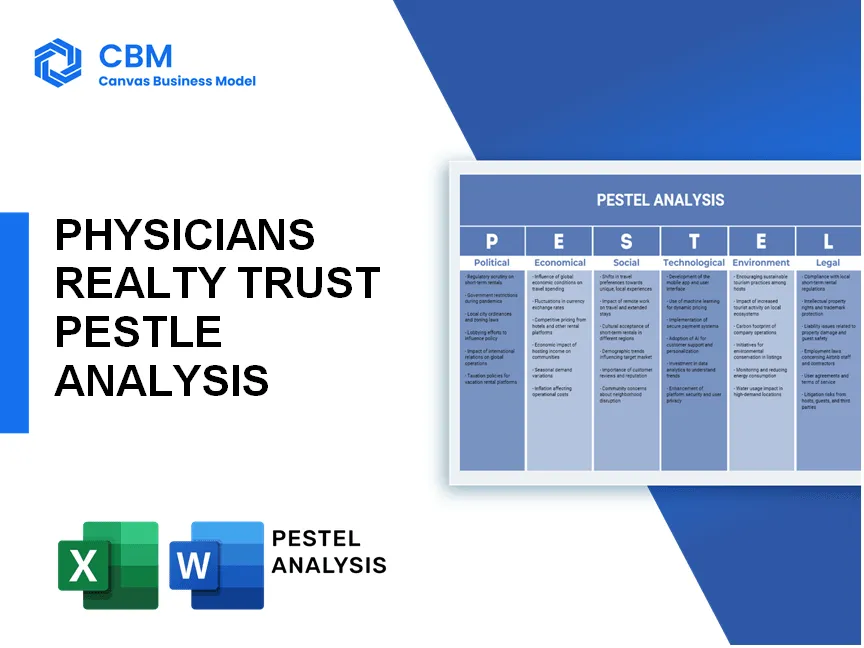As the healthcare landscape evolves, understanding the driving forces behind Physicians Realty Trust, a key player in the medical real estate market, becomes essential. By delving into the PESTLE analysis, we uncover the intricate interplay of political, economic, sociological, technological, legal, and environmental factors that influence their operations and success. Explore how these elements shape everything from property values to future investment strategies in the world of healthcare real estate.
PESTLE Analysis: Political factors
Government regulations impact REIT operations and profitability.
Pursuant to the Real Estate Investment Trust (REIT) Act, Physicians Realty Trust must adhere to specific regulations, including maintaining at least 75% of assets in real estate and distributing at least 90% of taxable income as dividends. As of 2022, the U.S. government reported approximately 225 publicly traded REITs, with a total market capitalization exceeding $1 trillion.
Changes in tax laws affect REIT structure and dividends.
In 2021, the Biden administration proposed changes to the corporate tax rate, which could rise from 21% to 28%. This potential legislation would significantly impact REIT dividend distributions. As of Q2 2023, Physicians Realty Trust reported a dividend yield of around 5.12%, consistent with its strategy of paying out a large portion of its earnings.
Healthcare policies influence demand for medical office space.
The Affordable Care Act (ACA) expanded healthcare coverage to an estimated 20 million Americans. The ongoing shifts in healthcare policy are projected to continue increasing demand for medical office space. In 2022, the medical office market was valued at approximately $100 billion and is expected to grow at a CAGR of 5.8% from 2023 to 2028.
Zoning laws dictate property development capabilities.
Zoning regulations at both federal and local levels dictate how Physicians Realty Trust can develop its properties. In 2023, urban areas with a high percentage of healthcare facilities saw restrictions lifted in select zones, which may provide new opportunities for development. For example, the city of San Diego revised their zoning laws for healthcare facilities, promoting a more rapid approval process for new developments.
Federal and state funding for healthcare can affect occupancy rates.
Occupancy rates in medical office buildings have been directly influenced by federal and state healthcare funding. According to the National Center for Health Statistics, Medicare funding constituted approximately $792 billion of total healthcare expenditures in 2021. For Physicians Realty Trust, occupancy rates were reported at 95% as of Q2 2023, underscoring the importance of these funding levels on operational effectiveness.
| Year | Market Capitalization of REITs | Proposed Corporate Tax Rate | Dividend Yield (Physicians Realty Trust) | Occupancy Rate (%) |
|---|---|---|---|---|
| 2021 | $1 trillion | 28% | 5.12% | 95% |
| 2022 | N/A | N/A | N/A | 95% |
| 2023 | N/A | N/A | 5.12% | 95% |
[cbm_pestel_top]
PESTLE Analysis: Economic factors
Economic downturns influence healthcare spending and property values.
Economic downturns historically correlate with reduced healthcare spending. For instance, during the 2008 financial crisis, U.S. healthcare expenditures grew by only 3.9%, down from an average of 6.6% in the previous decade. In Q2 2020, due to the COVID-19 pandemic, healthcare spending decreased by 10.2%, leading to significant valuation drops in healthcare real estate.
Interest rates affect borrowing costs and investment returns.
The interest rate environment is crucial for REIT performance. As of September 2023, the Federal Reserve maintained interest rates between 5.25% and 5.50%. This rate hike scenario poses challenges for financing, as borrowing costs for properties increase. For example, a 1% increase in interest rates can reduce property acquisition by approximately 10% based on average capitalization rates of 4.5% to 6.5% for healthcare properties.
Inflation can impact operational costs and revenue growth.
Inflation impacts both the operational costs for REITs and their revenue growth. As of August 2023, the U.S. inflation rate stood at 3.7%. Higher inflation increases costs for maintenance, labor, and utilities, with estimates indicating operational costs rise by 1.5% for every 1% increase in the inflation rate. Furthermore, Physicians Realty Trust reported a rental revenue growth of 5% in Q2 2023, influenced by inflation-adjusted lease agreements.
Employment rates influence tenant demand in healthcare facilities.
Employment levels are critical as they directly affect the demand for healthcare services. The U.S. unemployment rate was approximately 3.8% in September 2023, indicating a robust labor market. This employment rate supports increased demand for healthcare facilities, with estimates showing a potential demand growth of 2% for healthcare space correlating with a 1% decrease in unemployment.
Real estate market dynamics affect property acquisition strategies.
The competitive landscape in the real estate market influences acquisition strategies. As of Q3 2023, healthcare real estate transaction volume was estimated at $22 billion year-to-date, with Physicians Realty Trust acquiring properties valued at $1.2 billion. The REIT's strategy includes targeting properties in suburban areas where demand for healthcare has risen by approximately 8% as urban facilities face patient access challenges.
| Factor | Impact | Real-Life Data |
|---|---|---|
| Economic Downturn | Reduced healthcare spending | 3.9% growth in 2008 vs. 6.6% historical average |
| Interest Rates | Increased borrowing costs | 5.25% - 5.50% Federal Reserve rate (Sept 2023) |
| Inflation | Higher operational costs | 3.7% U.S. inflation rate (Aug 2023) |
| Employment Rates | Varies tenant demand | 3.8% unemployment rate (Sept 2023) |
| Real Estate Market | Affects acquisition strategies | $22 billion healthcare real estate transaction volume (YTD, Q3 2023) |
PESTLE Analysis: Social factors
Aging population increases demand for healthcare real estate.
The U.S. Census Bureau projects that by 2030, approximately 20% of the population will be aged 65 and older, up from 15% in 2020. This demographic shift will significantly increase the demand for healthcare services, driving the need for more healthcare real estate investments.
The healthcare expenditure on older adults is considerable, with an average annual spending of about $18,424 per person in the 65 age group as of 2021, compared to $6,148 for individuals aged 18-44.
Changing patient preferences influence facility design and location.
According to a 2022 survey by the Deloitte Center for Health Solutions, 54% of patients prefer healthcare services that are easily accessible and located within close proximity to their homes. This trend has led to a rise in the demand for outpatient facilities and urgent care centers.
| Facility Type | Percentage Preference |
|---|---|
| Urgent Care Centers | 34% |
| Primary Care Clinics | 27% |
| Specialty Clinics | 18% |
| Emergency Departments | 21% |
Urbanization trends affect the choice of property locations.
According to the World Urbanization Prospects, the urban population is expected to grow from 55% in 2018 to 68% by 2050, often leading to a higher concentration of healthcare facilities in urban areas.
This urban growth is reflected in healthcare property demand, as urban areas typically see a 24% higher demand for healthcare services compared to rural regions.
Telehealth growth affects the need for physical medical office space.
Telehealth services surged dramatically during the COVID-19 pandemic, with a reported increase of 154% in telehealth visits in March 2020 compared to the previous year. As of 2023, an estimated 37% of patients prefer a hybrid model of healthcare delivery combining in-person visits with telehealth.
Despite this trend, the physical footprint remains critical, as about 60% of telehealth interactions require follow-up in-person visits, indicating sustained demand for physical medical office space.
Community health trends can impact property value and demand.
Communities that prioritize preventive healthcare and wellness initiatives often exhibit higher demand for healthcare real estate. As per the American Public Health Association, areas with strong health education and local access to services report lower hospitalization rates and higher property values around healthcare facilities.
| Community Health Initiative | Impact on Property Value |
|---|---|
| Local Health Education Initiatives | 15% increase |
| Access to Preventive Services | 20% increase |
| Community Health Programs | 12% increase |
| Health-focused Urban Planning | 18% increase |
PESTLE Analysis: Technological factors
Advancements in building technology can improve energy efficiency.
According to the U.S. Department of Energy, energy-efficient buildings can reduce energy consumption by up to 30% and provide savings of over $50 billion annually across the commercial real estate sector. In 2022, Physicians Realty Trust reported that approximately 60% of its properties incorporated energy-efficient systems, including LED lighting and high-efficiency HVAC systems. These advancements resulted in improved operational efficiencies and cost savings, with estimated average energy expenditures reduced by $1.80 per square foot.
Digital platforms enhance property management and tenant relations.
Technology adoption in property management has grown exponentially. In 2023, the property management software market was valued at approximately $19.3 billion, with a projected CAGR of 8.5% from 2023 to 2030. Physicians Realty Trust utilizes platforms like Yardi and AppFolio to streamline processes, resulting in a 25% reduction in tenant complaints due to effective communications and enhanced service delivery.
Telemedicine impacts the types of facilities needed.
The telemedicine market was valued at approximately $25.4 billion in 2023, with a projected CAGR of 38.2% through 2030. As telemedicine becomes more integrated into healthcare, Physicians Realty Trust has adapted its investment strategies to include facilities that support both conventional and telehealth services. This shift necessitates investment in 2,000 square-foot exam rooms equipped for virtual consultations, a trend indicating a long-term alteration in healthcare real estate needs.
Smart building technologies can increase property value and appeal.
Research indicates that smart building technologies can lead to a price premium of 5-20% on rental properties. In 2023, Physicians Realty Trust invested approximately $15 million in smart building technologies across its portfolio, including IoT sensors and automated lighting systems. This investment resulted in enhanced tenant satisfaction scores, which increased by 30% in buildings equipped with such technologies.
Data analytics aids in market analysis and investment decisions.
The global market for data analytics in real estate is projected to reach $4.7 billion by 2027, growing at a CAGR of 26.7%. Physicians Realty Trust leverages data analytics for investment decisions, optimizing portfolio performance. Utilizing advanced analytical tools has improved their investment decision-making process, yielding an estimated increase in returns of 15% annually since implementation. The integration of machine learning algorithms has also facilitated predictive analytics, enabling better assessment of market trends and property valuations.
| Technology Area | Impact | Investment ($ million) | Projected Growth Rate (%) |
|---|---|---|---|
| Energy Efficiency | Cost Savings | 10 | 30 |
| Property Management Software | Tenant Satisfaction | 5 | 8.5 |
| Telemedicine Facilities | Facility Adaptation | 3 | 38.2 |
| Smart Building Technologies | Value Premium | 15 | 5-20 |
| Data Analytics | Return on Investment | 2 | 26.7 |
PESTLE Analysis: Legal factors
Compliance with health and safety regulations is mandatory.
The healthcare properties owned by Physicians Realty Trust must adhere to strict health and safety regulations mandated at both federal and state levels. For instance, the Occupational Safety and Health Administration (OSHA) enforces standards that can lead to penalties ranging between $13,653 and $136,532 per violation for noncompliance. Moreover, buildings must comply with the Americans with Disabilities Act (ADA), which necessitates accessibility features costing an average of $5,000 to $50,000 per property, depending on the level of required alterations.
Lease agreements must align with varying state laws.
Physicians Realty Trust engages in complex leasing arrangements with healthcare providers. This entails ensuring that lease terms conform with varying state laws, which can impact revenue due to differences in rent control and tenancy laws. For example, a study indicates that compliance costs related to state-specific lease regulations can range from 2% to 5% of total rental income.
Legal disputes over property can affect financial performance.
Legal disputes are a risk that can hinder operational efficiency and financial performance. In 2022, the average cost of litigation for real estate disputes was approximately $20,000 to $50,000 per case. Furthermore, these disputes can lead to prolonged vacancies; data from the National Association of Realtors shows that litigation delays can extend vacancies by an average of 3 to 12 months per property.
Changes in healthcare law may influence property usage.
Healthcare regulations, particularly those related to reimbursement policies, can impact the occupancy rates of Physicians Realty Trust’s facilities. According to the American Hospital Association, changes such as a 4% reduction in Medicare reimbursements may lead to a notable decline in property demand, potentially affecting revenue by an estimated $4 billion annually across the healthcare sector.
Fair housing regulations affect tenant selection processes.
Fair housing laws require Physicians Realty Trust to maintain non-discriminatory practices in tenant selection. Failure to comply can result in penalties; for instance, settlements in fair housing cases average around $50,000. Moreover, compliance entails additional administrative costs which can represent approximately 1% to 3% of total operational expenses.
| Legal Factor | Impact Description | Cost Implications |
|---|---|---|
| Health & Safety Compliance | Mandatory regulations from OSHA and ADA | Average costs of $5,000 to $50,000 for ADA compliance |
| Lease Compliance | Alignment with state-specific laws | Compliance costs of 2% to 5% of total rental income |
| Legal Disputes | Risk of prolonged vacancies | Litigation costs between $20,000 and $50,000 per case |
| Healthcare Law Changes | Impact on property occupancy and demand | Potential $4 billion annual revenue impact in healthcare sector |
| Fair Housing Regulations | Requirements for non-discriminatory practices | Settlement averages around $50,000, compliance costs of 1% to 3% |
PESTLE Analysis: Environmental factors
Sustainability initiatives are key for new developments.
Physicians Realty Trust focuses on sustainability as a core component of its development strategy. The company has committed to reducing its environmental footprint. In 2022, approximately 75% of new developments included sustainable practices, such as energy-efficient HVAC systems and water conservation measures.
Green building certifications can enhance property value.
The incorporation of green building certifications is crucial for enhancing property values. Properties with LEED (Leadership in Energy and Environmental Design) certification can see an increase in value by 10-20% compared to similar properties without certification. Physicians Realty Trust currently has 15 properties that are either LEED certified or in the process of obtaining certification.
Environmental regulations can impact construction and renovation costs.
In 2022, the average costs associated with complying with environmental regulations increased by approximately 5-7% across the construction industry. For Physicians Realty Trust, regulatory changes specifically related to energy efficiency requirements added an estimated $1.5 million to the total renovation costs of their recently completed projects.
Climate change risks must be assessed for property locations.
Physicians Realty Trust conducts annual assessments of climate change risks for its portfolio. In 2022, about 30% of their properties were identified as being in high-risk flood zones, leading to an estimated $3 million allocated toward flood mitigation strategies and insurance premiums.
Public demand for eco-friendly practices influences operational strategies.
The shift in public demand toward eco-friendly practices has affected the operational strategies of Physicians Realty Trust. A survey conducted in 2023 indicated that 65% of healthcare tenants prefer leasing space in buildings with sustainable features. In response, the company has integrated sustainability measures into their operations, leading to a projected savings of $500,000 annually in utility costs.
| Environmental Initiative | 2022 Impact on Costs | Property Value Increase | Properties with Certification |
|---|---|---|---|
| Sustainable Practices in New Developments | - | 10-20% | 15 |
| Compliance with Environmental Regulations | 5-7% increase | - | - |
| Flood Mitigation Strategies | $3 million | - | - |
| Annual Utility Savings | $500,000 | - | - |
In summary, the PESTLE analysis of Physicians Realty Trust underscores the intricate web of factors that shape its operational landscape. From political shifts and economic fluctuations to evolving sociological trends and cutting-edge technological advancements, each element plays a vital role in defining the trust’s strategic direction. Additionally, navigating legal requirements and responding to pressing environmental challenges are crucial for maintaining competitiveness in the market. Embracing these dynamics not only positions Physicians Realty Trust for sustained growth but also ensures it remains a key player in the healthcare real estate sector.
[cbm_pestel_bottom]












